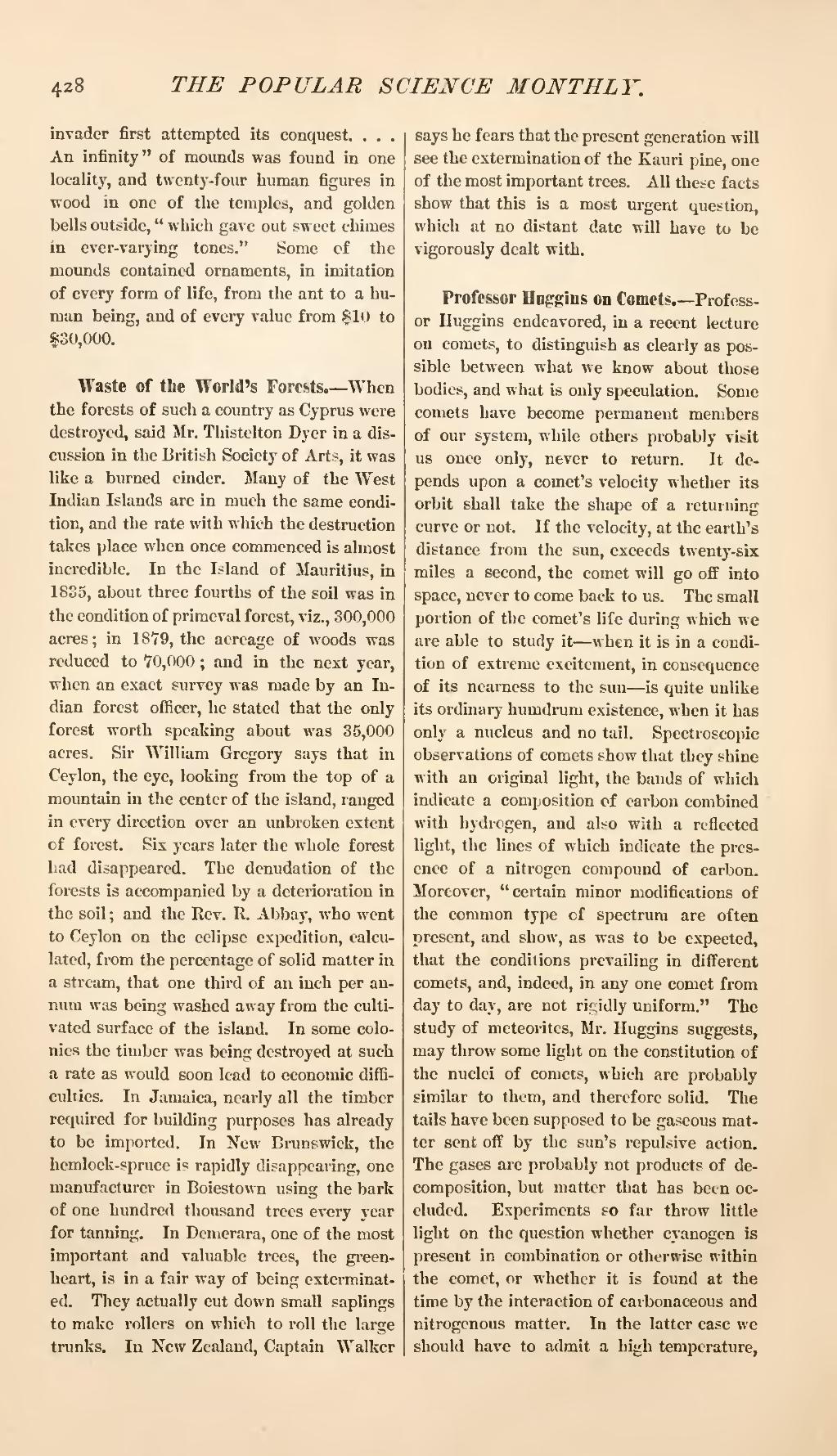invader first attempted its conquest. . . An infinity" of mounds was found in one locality, and twenty-four human figures in wood in one of the temples, and golden bells outside, "which gave out sweet chimes in ever-varying tones." Some of the mounds contained ornaments, in imitation of every form of life, from the ant to a human being, and of every value from $10 to $30,000.
Waste of the World's Forests.—When the forests of such a country as Cyprus were destroyed, said Mr. Thistelton Dyer in a discussion in the British Society of Arts, it was like a burned cinder. Many of the West Indian Islands are in much the same condition, and the rate with which the destruction takes place when once commenced is almost incredible. In the Island of Mauritius, in 1835, about three fourths of the soil was in the condition of primeval forest, viz., 300,000 acres; in 1879, the acreage of woods was reduced to 70,000; and in the next year, when an exact survey was made by an Indian forest officer, he stated that the only forest worth speaking about was 35,000 acres. Sir William Gregory says that in Ceylon, the eye, looking from the top of a mountain in the center of the island, ranged in every direction over an unbroken extent of forest. Six years later the whole forest had disappeared. The denudation of the forests is accompanied by a deterioration in the soil; and the Rev. R. Abbay, who went to Ceylon on the eclipse expedition, calculated, from the percentage of solid matter in a stream, that one third of an inch per annum was being washed away from the cultivated surface of the island. In some colonies the timber was being destroyed at such a rate as would soon lead to economic difficulties. In Jamaica, nearly all the timber required for building purposes has already to be imported. In New Brunswick, the hemlock-spruce is rapidly disappearing, one manufacturer in Boiestown using the bark of one hundred thousand trees every year for tanning. In Demerara, one of the most important and valuable trees, the greenheart, is in a fair way of being exterminated. They actually cut down small saplings to make rollers on which to roll the large trunks. In New Zealand, Captain Walker says he fears that the present generation will see the extermination of the Kauri pine, one of the most important trees. All these facts show that this is a most urgent question, which at no distant date will have to be vigorously dealt with.
Professor Huggins on Comets.—Professor Huggins endeavored, in a recent lecture on comets, to distinguish as clearly as possible between what we know about those bodies, and what is only speculation. Some comets have become permanent members of our system, while others probably visit us once only, never to return. It depends upon a comet's velocity whether its orbit shall take the shape of a returning curve or not. If the velocity, at the earth's distance from the sun, exceeds twenty-six miles a second, the comet will go off into space, never to come back to us. The small portion of the comet's life during which we are able to study it—when it is in a condition of extreme excitement, in consequence of its nearness to the sun—is quite unlike its ordinary humdrum existence, when it has only a nucleus and no tail. Spectroscopic observations of comets show that they shine with an original light, the bands of which indicate a composition of carbon combined with hydrogen, and also with a reflected light, the lines of which indicate the presence of a nitrogen compound of carbon. Moreover, "certain minor modifications of the common type of spectrum are often present, and show, as was to be expected, that the conditions prevailing in different comets, and, indeed, in any one comet from day to day, are not rigidly uniform." The study of meteorites, Mr. Huggins suggests, may throw some light on the constitution of the nuclei of comets, which are probably similar to them, and therefore solid. The tails have been supposed to be gaseous matter sent off by the sun's repulsive action. The gases are probably not products of decomposition, but matter that has been occluded. Experiments so far throw little light on the question whether cyanogen is present in combination or otherwise within the comet, or whether it is found at the time by the interaction of carbonaceous and nitrogenous matter. In the latter case we should have to admit a high temperature,

